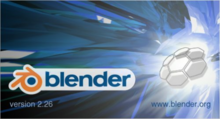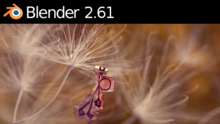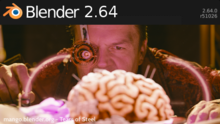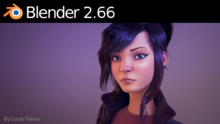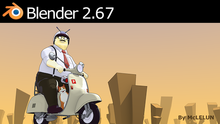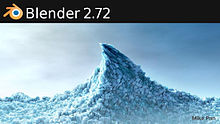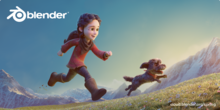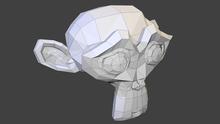Blender (software)
| Blender
|
|
|---|---|

|
|
 Screenshot of Blender 2.83.2 |
|
| Basic data
|
|
| developer | Blender Foundation |
| Publishing year | January 2, 1998 |
| Current version |
2.83.5 ( August 19, 2020 ) |
| operating system | Windows , Linux , macOS , Solaris , FreeBSD , IRIX , AmigaOS etc. a. m. |
| programming language | C , C ++ , Python |
| category | 3D graphics software |
| License | GPL ( Free Software ) |
| German speaking | Yes |
| www.blender.org | |
Blender is a free , GPL- licensed 3D graphics suite with which bodies can be modeled , textured and animated . These can be systematized in graphics, animations and software. Created image syntheses can be post-processed with the help of the integrated compositor and video editing program. The program is developed by professional and volunteer staff. C and C ++ are used as programming languages, Python is used as the scripting language .
Despite its range of functions, the program is relatively small (packed around 100 MB) and runs on most common computer systems. Since the source text is freely available, it can also be translated for your own platform if necessary. It is available as a portable app and can thus be operated on many systems, e.g. Windows, Linux, macOS, AmigaOS or FreeBSD, without installation (e.g. from a network drive or USB stick ).
Functionality
Blender is a program package for modeling , animation , image synthesis , video and image processing . Its dynamic user interface adapts to the respective tasks. This includes different object types ( polygon meshes , Bézier curves , NURBS surfaces , metaball , text, empty, lattice, armature and lamp objects), a large number of modifiers, polygon mesh processing and sculpting tools, the extensive material -Node system in which the properties of the materials can be changed with the help of shaders , which in turn can be influenced by values and textures, and finally the keyframing functions , as well as the tools for post-production . As of version 2.80, Blender has three internal rendering engines: the traditional engine Workbench Render , Cycles Render (which also supports ray tracing, among other things) and "Eevee", which is a so-called real-time render engine.
The outdated Blender Game Engine (BGE) has not been part of Blender since version 2.80. Open source alternatives are, for example, the Godot Engine , Armory3D or UPBGE.
Interaction Modes
There are different modes in which you can change objects.
- Object mode
- rough editing of objects (scaling and rotating) and arranging the scene
- Edit mode
- Modeling the points, edges and surfaces of an object
- Sculpt fashion
- With a multiresolution modifier or dynamic topology you can edit an object with different brushes without moving individual points.
- Vertex Paint
- One can Vertex create groups by inking individual points.
- Weight paint
- Vertex groups can be created by coloring the points. If an object is blue then it has no effect, if an object or point is red then it has full effect. All color gradations in between have an effect in between.
- Texture Paint
- Objects can be textured with a UV map .
user interface
The user interface of the program is made up of regions, which can be dynamically arranged, scaled and shown or hidden. A menu can be placed in each of them. Menus are divided into toolbars (panels) in which there are controls . The numerous key combinations enable efficient and fast work.
Blender contains u. a. the following menus :
- 3D view:
- The 3D view is a central menu of the program, which is made up of the viewport (a preview in which the scenery is abstracted), a bar on which the basic settings for the scenery can be made, and another bar, the simple Entries enabled.
- Properties:
- Settings for the selected object can be made in the Properties menu. It can u. a .:
- Make settings to prepare the image synthesis
- Make settings for the scenery
- Make settings for the background
- Make settings for the object
- Include constraints
- Manage materials
- Add modifiers
- Manage textures
- Manage particle and physics simulations
- Settings for the selected object can be made in the Properties menu. It can u. a .:
- Timeline:
- The timeline is an animation tool. It enables u. a .:
- Show a preview of created animations in the viewport
- To display different frames of the animation in the viewport
- To set keyframes
- The timeline is an animation tool. It enables u. a .:
- Node editor
- All work for which nodes can be used can be carried out in the Node Editor. It can be used in the following areas:
- Shading
- Texturing
- Compositing
- All work for which nodes can be used can be carried out in the Node Editor. It can be used in the following areas:
- UV / Image Editor
- In the UV / Image Editor you can insert images or UV maps (2D images of a 3D object). It can be used for:
- Texturing
- Map references
- Projection Paint
- In the UV / Image Editor you can insert images or UV maps (2D images of a 3D object). It can be used for:
Several scenes can be created within one file to organize the projects. Objects can be placed on different levels (layers) so that they can be edited separately and shown and hidden.
Bodies can be edited in different modes. If an object is assigned to a mode, control elements which are important for working in this mode are displayed in the 3D view. In addition, the visualization of the object in the viewport is adapted to the mode function. This is to create clarity.
Features
- Blender works with polygon meshes , Bézier curves , NURBS surfaces, Metaball and text objects. The support for the processing of polygon meshes (from version 2.63 also with more than 4 corners per polygon) is a clear focus. The following are available for this:
- Subdivision surfaces ( Subdivision Surfaces )
- Multiresolution networks, i.e. objects in several levels of resolution
- Sculpting tools that can be used to deform objects such as virtual clay
- Blender has material and texturing tools :
- Various UV unwrapping methods (including Angle-Based, Conformal, Smart Projections)
- node-based material and texture editors that allow very complex materials
- 3D painting tools allow you to paint directly on the model
- Support for graphics tablets
- The animation tools include:
- Shape-Keys (Morph Targets)
- Character animations with direct and inverse kinematics
- Deformations based on curves and lattice (cage)
- Simulation of elastic objects (softbodies), including collision detection
- Simulation of solid bodies (Rigidbodies), also with collision detection
- Clothing simulation
- particle-based hair, grass, etc.
- Particles with collision detection
- Fluid dynamics
- Blender uses its own file format marked with ".blend", which is difficult to access with other programs. It is cross-platform and up and down compatible. Import and export scripts are integrated for various formats, e.g. B. for OBJ and FBX files, and can also be expanded using plug-ins.
- Python is used as the scripting language.
- The 3D game engine is also programmed in Python . With this standalone real-time applications can be created in Blender.
- Blender contains a simple but functional video editing program, which allows the resource-saving handling of large files.
- Blender includes an extensive node-based compositor to edit images and animations directly in the program.
- Blender can be used in video monitor (version 2.61 points tracking ) and from its position in space can be calculated. This means that both the movement of the camera and that of objects can be transferred to Blender. This is suitable, for example, to put animated models in real recordings.
Render engines
Blender can output the created scenes to a final image using various render engines. The default setting after the program starts is the classic renderer Blender Internal , which has been included since the earliest Blender releases. In addition, the program from version 2.6 also contains an unbiased rendering engine called "Cycles", which can also be performed in real time, i.e. H. works while editing and can also render with the GPU using CUDA and OpenCL . In addition, an OpenGL preview can be output, the display of which can, however, clearly depend on the graphics hardware used.
Regardless of the rendering engine used (also with the OpenGL preview), the generated images can be saved in various output formats including HDR , EXR or various video formats. Thanks to the FFmpeg libraries used, this output is independent of the codecs installed on the system.
Cycles has been continuously developed since it was first published and has established itself as the new standard engine among users. The classic renderer Blender Internal has not been further developed for a long time and is no longer part of Blender from version 2.8; The Blender Game Engine has also been omitted and is to be replaced by an alternative. Instead of the engine Blender Internal, the real-time engine Eevee has now appeared.
Both render engines are fully multi-threaded and support, among other things:
- Edge rendering (cartoon lines)
- Ray tracing
- Near occlusion (ambient occlusion)
- Radiosity
- layered rendering and compositing
- Rendering of volumetric particles
- Hair and fur
- Motion blur
In addition to the three internal renderers, various external render engines can be used (e.g. YafaRay Kerkythea , Indigo or LuxRender ).
history
Blender was originally an in-house program of the Dutch animation studio NeoGeo. The chief developer Ton Roosendaal founded the company Not a Number Technologies (NaN) in 1998 to further develop and sell blenders. After NaN's bankruptcy , the creditors agreed to release Blender as open source for an amount of 100,000 euros and to place it under the free software license GNU General Public License (GPL). On July 18, 2002, Ton Roosendaal founded the Blender Foundation with the aim of collecting donations. On the following September 7th, the goal of 100,000 euros was achieved. This fundraising strategy is also called the Street Performer Protocol or crowdfunding .
The program made essential development steps with the following versions:
| version | publication | Notes and most important changes |
|---|---|---|
| 2.03 | around 2002 | Manual The official Blender 2.0 guide |
| 2.26 | August 20, 2003 | Normalmap menu of Blender version 2.26, first free version |
| 2.30 | November 22, 2003 | new user interface ; for the first time the possibility to undo editing steps |
| 2.32 | February 3, 2004 | Ray tracing in the internal renderer ; Support for YafaRay |
| 2.34 | August 5, 2004 | LSCM-UV unwrapping, interaction of objects with particles |
| 2.37 | May 31, 2005 | Simulation of elastic objects, improvement of the subdivision surfaces system |
| 2.40 | December 22, 2005 | Much improved animation system with better character animations, actions and an editing tool for non-linear animation, simulation of liquids and hair. The large new range of functions was based to a large extent on the projects of the Google Summer of Code 2005. |
| 2.41 | January 25, 2006 | Game engine improvements (programmable vertex and pixel shaders , use of blender materials, split screen mode , physics engine improvements ), improved UV mapping , inclusion of the Python script for sculptors - or sculpture - Working with the help of grid or mesh models ( mesh sculpting ) and set-chaining , |
| 2.42 | July 14, 2006 | The film Elephants Dream brought about a great boost in development in all areas that are necessary for the production of a film. In particular, the node system (material and composite nodes) was implemented. |
| 2.43 | February 16, 2007 | Sculpt modeling as a result of the Google Summer of Code 2006 |
| 2.46 | May 19, 2008 | With the production of the new open movie Big Buck Bunny , Blender was expanded to include functions to easily create grass and fur and to render them quickly. |
| 2.48 | October 14, 2008 | The original blender game engine was used for the development of the free game Yo Frankie ! reintegrated into Blender in an updated form. In addition, a better material preview was introduced. |
| 2.49 | June 13, 2009 | knot-based materials and textures; Game engine improvements and many bug fixes |
| 2.57 | April 13, 2011 | First official stable version of the 2.5 branch: new user interface, new window manager as well as rewriting of the event, tool and file processing system, new animation system (every setting can now be animated), new Python API |
| 2.58 | June 22, 2011 | Over 200 bug fixes, some new features |
| 2.58a | 4th July 2011 | Cover picture of this version like 2.58, some bug fixes, small enhancements in GUI and Python interface |
| 2.59 | August 13, 2011 | Support for 3D mice, lots of bug fixes |
| 2.60 | October 19, 2011 | Development branches are integrated into the main development branch: including B-Mesh, a new rendering / shading system, Nurbs, some GSoC projects |
| 2.61 | December 14, 2011 | Render Engine Cycles, Motion Tracking , Dynamic Paint, Ocean Simulator (ocean simulator) |
| 2.62 | February 16, 2012 | Extension of motion tracking to object tracking, further extension of UV tools and Cycles rendering engine, remesh modifier, 205 bug fixes |
| 2.63 | April 27, 2012 | Bug fixes, BMesh project: Completely new polygon mesh system with n-corners and new tools: Dissolve, Inset, Bridge, Vertex Slide, Vertex Connect, Bevel |
| 2.64 | 3rd October 2012 | Mask editor, motion tracking optimizations, chroma key tools, compositor update with multi-core and GPU support, speed optimizations of the Cycles render engine , bug fixes and minor improvements in many areas. |
| 2.65 | December 10, 2012 | New fire simulation and speed optimization of the smoke simulation, OSL (Open Shading Language) support for Cycles, Motion Blur for Cycles, normal map support, bevel revision, bug fixes and minor improvements in several areas. |
| 2.66 | February 21, 2013 | Better integration of the physics engine Bullet , Sculpten with dynamic topology ( Dynamic Topology Sculpting ), various innovations in Cycles render engine - including the representation of hair, bristles or other strands (English strands ) Matcaps in the viewport , various improvements on the user interface, retina display support, bug fixes and other minor improvements. |
| 2.67 | May 7, 2013 | Integration of the cartoon renderer Freestyle; Changes to the user interface; minor changes in the game engine. |
| 2.68 | 18th July 2013 | Emphasis on stability and speed; Render-Engine Cycles offers several new shaders, such as one for wireframe models and a toon shader; the bridge tool has been improved; Python scripts are now disabled by default when loading a file for security reasons. |
| 2.69 | October 30, 2013 | The representation of light scattering in translucent fabrics (Subsurface Scattering, SSS) of the integrated Cycles renderer has been significantly improved, but only works when rendering on the CPU; the new "Mesh-Bisect" tool can cut objects in half along a plane and automatically fill the cut edges; Looks simulates analog film types from manufacturers such as Agfa or Kodak; Blender now offers two sky simulations to choose from; the motion tracker can now perform plane tracks, tracking an area in the scene; Scenes in FBX format can be imported complete with cameras, lamps and meshes including UV textures and vertex colors. |
| 2.70 | March 19, 2014 | Rudimentary support for volumetric materials, accelerated CPU rendering by using the SSE instruction set (up to 30% faster); Sample numbers for direct and indirect light can be set individually; newer functions and higher performance with OSL through version 1.4.x; various new or improved motion tracking features; various UI improvements; numerous changes to modifiers; new options for bevel, knife, snapping and dynamic topology sculpting tools; Introduction of a kind of performance monitor; minor game engine improvements (including support for PSD files); further improvement of the freestyle implementation; More functions. Another modifier: Wireframe |
| 2.70a | April 10, 2014 | (Cover picture of this version like 2.70), various bug fixes Blender 2.68 Splash |
| 2.71 | June 26, 2014 | In planning - Python 3.4, Split Normals, F-Curve Easing patch, Cycles Baking, Cycles SSS with GPU-Render, Multi View (Stereo 3D). |
| 2.72 | 4th October 2014 | Freestyle in Cycles, Sun Beams, Pie Menus |
| 2.72a | 15th October 2014 | (Title picture of this version like 2.72), Some bug fixes |
| 2.72b | October 22, 2014 | Title picture of this version like 2.72, some bug fixes |
| 2.73 | January 7, 2015 | Freestyle SVG exporter, animatable Grease Pencil, miscellaneous, |
| 2.73a | 20th January 2015 | Title picture of this version like 2.73, some bug fixes |
| 2.74 | March 31, 2015 | The Cycles engine has been accelerated and, according to developers, requires less memory; Viewport compositing allows surrounding obscuration and depth of field, which can be determined using a pipette filler. The transfer of data levels is now also possible. The particle system and hair modeling have been improved |
| 2.75 | July 1, 2015 | Dynamic topology improved, multi-view and stereo 3D pipeline integrated |
| 2.75a | July 8, 2015 | Title picture of this version like 2.75, some bug fixes |
| 2.76 | October 11, 2015 | User Interface, Modeling, OpenSubdiv, Sequencer, Freestyle NPR Rendering, Animation, Game Engine, Add-ons, More Features, Bug Fixes |
| 2.76b | 3rd November 2015 | Title picture of this version like 2.76, some bug fixes |
| 2.77 | 19th March 2016 | Subsurface scattering accelerated, motion blurring in cycles via shutter curves, rolling shutter effect, storage of fire and smoke simulations in OpenVDB format, bug fixes, Windows XP support will be ended with Python 3.5.1, 2.77a: bug fixes |
| 2.78 | September 30, 2016 | Panoramas for stereo VR, revision of the Grease Pencil, improvements in rendering for Cuda, OpenCL for various hardware, multithreading: up to 1024 threads instead of the previous max. 64 |
| 2.78b | February 8, 2017 | Acceleration of cycles, bug fixes |
| 2.78c | February 28, 2017 | Bug fixes |
| 2.79 | 11th September 2017 | PBR shader "Principled BSDF", Denoiser, Filmic Color Management, Shadow Catcher, improvements for the Grease Pencil, improvements in the cycle render, improvements for OpenCL, better Alembic import / export, other small changes and bug fixes |
| 2.80 | July 30, 2019 | New UI with OpenGL 3.3+, new EEVEE renderer (very fast and based on physical principles), the previous layer system has been replaced by new collections, new 2D animation system for Grease Pencil, additional shaders for the Cycles renderer and much more more |
| 2.81a | November 21, 2019 | Revision of the modeling tools, support for NVIDIA RTX Ray Tracing for the Cycles Render Engine, Intel Open Image Denoiser, improved menu and navigation, new file browser and improved file management, improvements to the real-time render engine EEVEE, bug fixes and much more |
| 2.82 | February 15, 2020 | Integrated Mantaflow for better simulations, UDIM support (UV coordinates distributed over several image files), USD support (Universal Scene Description, a format developed by Pixar for 3D data) and much more. |
| 2.82a | March 12, 2020 | Bug fixes |
| 2.83 | 3rd June 2020 | Two years of Long Time Support (»LTS«), OpenVDB import (free format to describe volumes like fog and smoke), fabric simulation with a sculpting brush, EEVEE render passes, VR for scene editing, AI-accelerated denoising. |
|
Old version
Current version
Future version
|
||
An overview of all published program versions can be found on the official website and in the German-language manual in the chapter "The history of Blender".
Suzanne
When it became clear in January 2002 that NaN would close its doors in March, the developers wanted to add a "personal touch" to their last release (v2.25) and added a mesh basic model (primitive) as a kind of Easter egg of a monkey head. This was created by Willem-Paul van Overbruggen and is named after an orangutan from the movie Jay and Silent Bob Strike Back . Suzanne, who is simply referred to as “Monkey” in the software in the menus, was retained in the later open source releases, quickly gained cult status in the Blender community and thus became the Blender mascot.
Suzanne is a low-poly model (only 500 polygons ) and is the alternative to the otherwise common Utah teapot in Blender . It is often used as a quick and easy way to test materials, textures and light setups. Suzanne is optimized to be displayed using a subdivision surface modifier.
As part of the annual Blender Conference in Amsterdam, an animation prize called the “Suzanne Award” is presented.
commitment
Blender is both of individuals and of smaller studios used since the software over other popular 3D graphics suites has the advantage of being available free of charge and in addition to modeling, texturing and Renderingfuktionen through menus to sculpting, to video editing and digital post-processing features .
Example graphics
Use in film projects and video games
- In September 2005, some of the most respected blender artists and developers began work on a short film. They mainly used free software . This project is known as the Orange Movie Project . The resulting film, Elephants Dream , premiered on March 24, 2006, was released on DVD in May 2006 and released for download via file sharing networks.
- Another film project called Big Buck Bunny was released on DVD on May 20, 2008. It is the follow-up project to Elephants Dream .
- The open source game Yo Frankie , created by experienced game developers in Blender, has been available on DVD since November 14, 2008 and on the Internet since December 9, 2008. The open source engines Crystal Space and the blender-internal engine are used as graphics engines . The game can be changed and expanded in Blender itself.
- The 80-minute animated film "Plumiferos" was made in Argentina and premiered on February 18, 2010 in Buenos Aires.
- On September 1st, 2009 the third Open Movie Project started under the working title Durian . The finished film called Sintel premiered on September 28, 2010 at the Dutch Film Festival; The film has been available for download since September 30, 2010 and can be viewed on public video platforms such as YouTube .
- The fourth Open Movie Project of the Blender Foundation with the project name Mango started in October 2011 . The aim of the project was to expand the functionality in the area of visual effects. The finished film is called Tears of Steel and premiered on September 26, 2012. In the twelve-minute short film, a group of fighters and scientists try to save the earth from being destroyed by robots. The complete film is freely available as torrent, the source material (PNG individual images, stereo and 5.1 sound, render in 4000 × 2000 pixels and other project files) has also been published.
- In the virtual worlds Second Life and OpenSim , objects such as buildings, vehicles or clothing are often designed by players.
literature
- Heiko Ihde: Blender: Your entry point into professional 3D graphics and animation , Addison-Wesley, December 2011, ISBN 978-3-8273-2899-1 Includes version 2.5 and higher
- Thomas Hintz, Immanuel Günther: Material design with blender. Basics - Planning - Implementation , Open Source Press, March 2011, ISBN 978-3-941841-24-6
- Carsten Wartmann: The Blender Book. 3D graphics and animation with Blender. 5th updated edition dpunkt.verlag, Heidelberg 2014, ISBN 978-3-86490-051-8 . Considers version 2.69
- Heiko Ihde: Blender 2.5 and higher , video training on DVD, Addison-Wesley, ISBN 978-3-8273-6382-4
- Helge Maus: Blender 2.5 - The comprehensive training , video training on DVD, Galileo Design, ISBN 978-3-8362-1520-6
- Ruben Buchholz: The blender training for advanced users , video training on DVD, Galileo Design, ISBN 978-3-8362-1759-0
- Sebastian König: Blender 2.6 - The comprehensive training , video training on DVD, Galileo Design, ISBN 978-3-8362-1872-6
- Sebastian König: The Blender Training: Compositing & Rendering , Video Training on DVD, Galileo Design, ISBN 978-3-8362-2392-8
- Thomas Beck: Blender 2.7 - The comprehensive manual , Galileo Design, 776 pages, 2014, hardback, in color, with DVD; ISBN 978-3-8362-2496-3
Web links
- Official website (English)
- Blender Wiki
Individual evidence
- ↑ Ton Roosendaal: How Blender started, twenty years ago… . In: Blender . December 27, 2013 (accessed August 22, 2020).
- ↑ Ton Roosendaal: Blender's 25th birthday! . In: Blender . January 2, 2019 (accessed August 22, 2020).
- ↑ Blender LTS . In: Blender . August 19, 2020 (accessed August 22, 2020).
- ↑ About - Blender.org - Home of the Blender project. In: Blender.org - Home of the Blender project. Blender Foundation, accessed on April 23, 2016 (English, license: https://www.blender.org/about/license/ software type: https://www.blender.org/about/ ).
- ↑ Features - blender.org - Home of the Blender project. In: blender.org - Home of the Blender project. Blender Foundation, accessed April 23, 2016 .
- ↑ Download Blender (all versions). In: download.blender.org. Retrieved April 23, 2016 .
- ↑ Get Involved - blender.org - Home of the Blender project. In: blender.org - Home of the Blender project. Blender Foundation, accessed April 23, 2016 .
- ↑ Why You Should be Striving for Photorealism by Andrew Price, presentation at Pausefest 2015 on YouTube
- ↑ Blender Foundation: blender.org - Home of the Blender project - Free and Open 3D Creation Software. Features. In: blender.org. Retrieved May 7, 2016 .
- ↑ Introduction - Blender Reference Manual. In: blender.org - Home of the Blender project. Retrieved October 31, 2018 .
- ↑ Interface - Blender Reference Manual. In: www.blender.org. Retrieved June 3, 2016 .
- ↑ a b Scenes - Blender Reference Manual. In: www.blender.org. Blender Foundation, accessed October 31, 2018 .
- ↑ Blender Documentation: Modi - Wikibooks, collection of free text, non-fiction and specialist books. In: de.wikibooks.org. Retrieved May 15, 2016 .
- ↑ What's New in Blender 2.80. Retrieved February 26, 2016 .
- ↑ https://www.blendernation.com/2018/04/24/blender-today-live-rip-blender-internal-rip-game-engine/
- ↑ EEVEE FAQ Accessed on February 26, 2019 (English).
- ↑ Blender Foundation Launches Campaign to Open Blender Source on linuxtoday (July 22, 2002)
- ↑ 'Free Blender Fund' campaign ( Memento of October 10, 2002 in the Internet Archive ) archived in 2002
- ↑ Membership ( Memento of October 10, 2002 in the Internet Archive ) People can subscribe to become Foundation Member. Members who subscribe during the campaign period, get additional benefits for their support. During campaign: - Costs: minimum one time fee of EUR 50 (or USD 50) (archived 2002)
- ↑ Blender Foundation (English) - page at blender.org ; Status: May 1, 2006
- ↑ Index of / source / (English) - page at blender.org ; Status: October 13, 2010
- ↑ a b Blender Documentation: The Story of Blender - Chapter at Wikibooks , September 5, 2009
- ↑ https://www.heise.de/newsticker/meldung/3D-Software-Blender-jetzt-mit-Undo-88677.html
- ↑ https://www.heise.de/newsticker/meldung/Blender-2-34-neue-Version-der-Open-Source-3D-Software-104165.html
- ↑ Blender 2.40 (English) - page at blender.org ; As of December 23, 2005
- ↑ https://www.heise.de/newsticker/meldung/Open-Source-3D-Software-Blender-mit-neuen-Fätze-160765.html
- ↑ https://www.heise.de/newsticker/meldung/Freies-3D-Paket-Blender-mit-Filmerlebnis-142385.html
- ↑ https://www.heise.de/newsticker/meldung/Blender-2-43-Mit-dem-3D-Pinsel-modellieren-147772.html
- ↑ 3D software Blender 2.46 released for download - article at Heise online , May 20, 2008
- ↑ Blender 2.48 ( Memento from January 20, 2009 in the Internet Archive ) (English) - page at blender.org ; As of December 25, 2008
- ↑ https://www.heise.de/newsticker/meldung/Blender-2-48-Der-will-nicht-nur-piele-211505.html
- ↑ Blender 2.49 ( Memento from June 11, 2009 in the Internet Archive ) (English) - page at blender.org ; As of June 21, 2009
- ↑ Blender 2.57 (English) - Announcement on the official website, April 13, 2011
- ↑ blenderfoundation: Blender 2.58a update log. (No longer available online.) Blender.org, July 9, 2011, archived from the original on July 7, 2011 ; Retrieved July 10, 2011 (English).
- ↑ https://www.heise.de/newsticker/meldung/SIGGRAPH-2011-Blender-fuer-visuelle-Effekte-aufgebohrt-1319911.html
- ↑ https://www.heise.de/newsticker/meldung/Blender-2-60-unterstuetzt-Audio-Objekte-1364177.html
- ↑ https://www.heise.de/newsticker/meldung/Blender-2-63-mit-Vielseiten-Polygonen-1563983.html
- ↑ Blender 2.64 - the Open Source VFX pipeline. (No longer available online.) Blender.org, October 3, 2012, archived from the original on April 20, 2013 ; accessed on October 4, 2012 .
- ↑ https://www.heise.de/newsticker/meldung/Blender-2-65-macht-Feuer-1766143.html
- ↑ Blender 2.66 animated with bullet physics - article at Heise online , from February 21, 2013 (accessed on: February 27, 2013)
- ↑ Blender 2.67 release logs. (No longer available online.) Blender Foundation , May 30, 2013, archived from the original on June 2, 2013 ; accessed on May 31, 2013 .
- ↑ https://www.heise.de/newsticker/meldung/Blender-2-67-rendert-Cartoons-1858698.html
- ↑ Blender 2.68 release logs. (No longer available online.) Blender Foundation, July 18, 2013, archived from the original on August 6, 2013 ; Retrieved July 18, 2013 .
- ↑ https://www.heise.de/newsticker/meldung/Blender-2-68-rendert-schneller-1920266.html
- ↑ Blender 2.69 release logs. (No longer available online.) Blender Foundation, Oct. 31, 2013, archived from the original on Nov. 2, 2013 ; accessed on October 31, 2013 .
- ↑ https://www.heise.de/newsticker/meldung/Open-Source-3D-Paket-Blender-2-69-Gekommen-um-zu-bleiben-1981197.html
- ↑ Blender 2.70 Release Notes ( Memento from March 31, 2014 in the Internet Archive )
- ↑ https://www.heise.de/newsticker/meldung/Blender-2-70-3D-Paket-mit-neuer-Oberflaeche-2140668.html
- ↑ http://www.blendernation.com/2014/03/31/developer-meeting-notes-march-30-2014/
- ↑ Blender 2.71 Release Notes ( Memento from March 22, 2014 in the Internet Archive )
- ↑ https://www.heise.de/newsticker/meldung/Blender-2-71-Rendering-auf-der-Zielgerade-2239247.html
- ↑ Blender 2.72 Release Notes ( Memento from October 3, 2014 in the Internet Archive )
- ↑ https://www.heise.de/newsticker/meldung/Open-Source-3D-Paket-Blender-in-Version-2-72-2409588.html
- ↑ Blender 2.72a: Bug Fixes ( Memento from January 10, 2015 in the Internet Archive )
- ↑ Blender 2.72b: Bug Fixes ( Memento from January 10, 2015 in the Internet Archive )
- ↑ Blender 2.73 Release Notes ( Memento from January 8, 2015 in the Internet Archive )
- ↑ Blender 2.73a: Bug Fixes ( Memento from March 15, 2015 in the Internet Archive )
- ↑ Mirko Lindner: Blender 2.74 released. In: pro-linux.de. April 1, 2015, accessed April 1, 2015 .
- ↑ Blender 2.74 Release Notes ( Memento from April 6, 2015 in the Internet Archive )
- ↑ https://www.heise.de/newsticker/meldung/Die-3D-Software-Blender-2-74-hat-die-Haare-schoen-2592920.html
- ↑ https://www.heise.de/newsticker/meldung/Blender-2-75-Stereoskopisch-und-gratis-in-3D-animieren-2730606.html
- ↑ Blender 2.76 Release Notes ( Memento from October 26, 2015 in the Internet Archive )
- ↑ https://www.heise.de/make/meldung/Open-Source-3D-Paket-Blender-2-76-leger-Tempo-vor-2837965.html
- ↑ https://www.heise.de/ct/artikel/3D-Paket-Blender-2-76-work-deutlich-schneller-2837963.html
- ↑ heise online: Blender 2.77 cuts off old braids. In: heise online. Retrieved March 16, 2016 .
- ↑ https://www.heise.de/ct/artikel/Open-Source-3D-Suite-Blender-2-77-weiter-optimiert-3136031.html
- ↑ Blender 2.77a: Bug Fixes ( Memento from October 1, 2016 in the Internet Archive )
- ↑ tone, Brecht, Fablefox, Lijenstina, Mont 29: Blender 2.78 release notes. The Blender Foundation and online developer community are proud to present Blender 2.78. In: Blender Wiki. Retrieved November 30, 2018 .
- ↑ Gottfried Hofmann: 3D graphics software Blender 2.78 renders stereo VR. In: heise online. Verlag Heinz Heise, September 30, 2016, accessed on October 2, 2016 .
- ↑ Gottfried Hofmann: Blender 2.78: From 2D cartoons to VR. In: c't - magazine for computer technology. Verlag Heinz Heise, September 30, 2016, accessed on October 2, 2016 .
- ↑ Dev: Ref / Release Notes / 2.78 / Performance update - BlenderWiki. (No longer available online.) Archived from the original on November 30, 2018 ; accessed on November 30, 2018 (English).
- ↑ Dev: Ref / Release Notes / 2.78 / Performance update2 - BlenderWiki. (No longer available online.) Formerly in the original ; accessed on November 30, 2018 (English). ( Page no longer available , search in web archives ) Info: The link was automatically marked as defective. Please check the link according to the instructions and then remove this notice.
- ↑ tone, Brecht, Fablefox, Lijenstina, Mont 29: Blender 2.79 release notes. The Blender Foundation and online developer community are proud to present Blender 2.79. In: Blender Wiki. Retrieved September 12, 2017 (English).
- ↑ https://www.heise.de/ct/artikel/Freie-3D-Software-Blender-2-79-3829075.html?hg=1&hgi=5&hgf=false
- ↑ Reference / Release Notes / 2.80 - Blender Developer Wiki. Retrieved November 30, 2018 .
- ↑ https://code.blender.org/2017/05/viewport-past-present-and-future/
- ↑ - ( Memento from September 21, 2017 in the Internet Archive )
- ↑ https://wiki.blender.org/index.php/Dev:Ref/Release_Notes/2.80
- ↑ https://www.blender.org/2-8/
- ↑ Release / 2-81 - Blender. Retrieved November 22, 2019 .
- ↑ https://wiki.blender.org/wiki/Reference/Release_Notes/2.82
- ↑ https://www.heise.de/newsticker/meldung/3D-Software-Blender-2-82-Wasser-Feuer-und-Rauch-simulates-4661622.html
- ↑ Release-Logs (English) - page at blender.org ; As of May 31, 2009
- ↑ Past releases - blender.org - Home of the Blender Project. In: blender.org - Home of the Blender Project. Blender Foundation, accessed April 27, 2016 .
- ^ Sintel, the Durian Open Movie Project (English) - official website; Status: October 2, 2010
- ↑ Nederlands Film Festival (Dutch) - official website; Status: October 12, 2010
- ↑ mango.blender.org
- ↑ Tears Of Steel-Download and Watch (English) - official website; As of June 14, 2013


